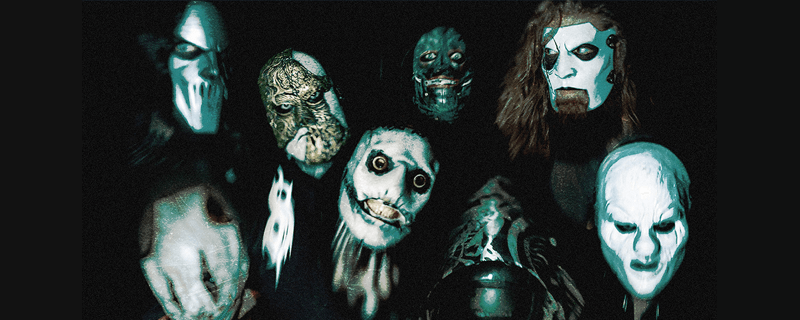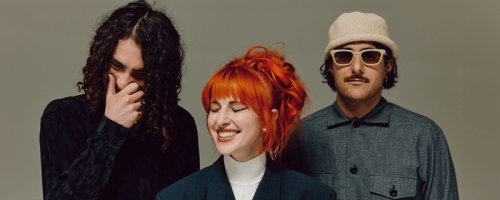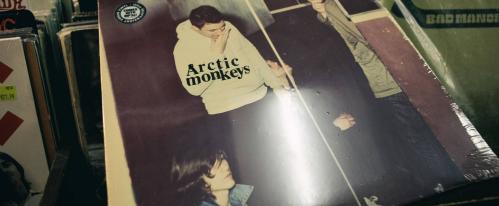Distinctly known as one of the best heavy metal bands of all time, Slipknot’s live show reputation of blisteringly gnarly riffs, rapid drums, ferocious vocals and of course their iconic masks have earned them the top spots at some of the biggest festivals, number one albums and a legion of devoted fans (affectionately called Maggots) across the globe since their debut self-titled album back in 1999.
Consisting of a whopping nine members in the band, you can imagine they use a large amount of equipment during live shows and in the studio. From Jim Root and Mick Thomson’s guitar rigs to Sid Wilson’s DJing equipment, an incredible amount of gear is used to give the band their behemoth sound.
In this blog, we’ll give you the definitive rig rundown of the band, unravelling the mysteries behind the gear that fuels the heavy metal kings, and giving alternatives to their gear for players on a smaller budget. Let’s dive in…
Corey Taylor - #8
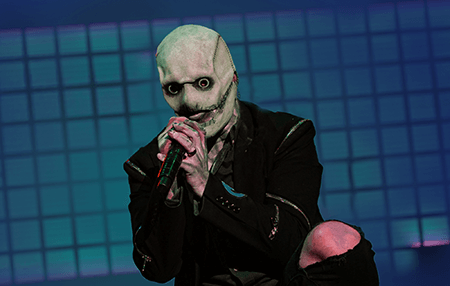

The leading voice behind the mask in the Grammy-winning heavy metal band; as the lead vocalist Taylor's distinct and powerful vocals have been a driving force behind the band's success, as well as on his own solo work and side project, Stone Sour.
Known for his intense stage presence and passionate lyrics, he has become a defining figure in the metal scene. Corey's contribution to Slipknot goes beyond the music, as he embodies the band's theatrical and enigmatic persona, solidifying his status as a key influencer in the world of heavy metal.
What Microphone Does Corey Taylor Use?
Shure SM58
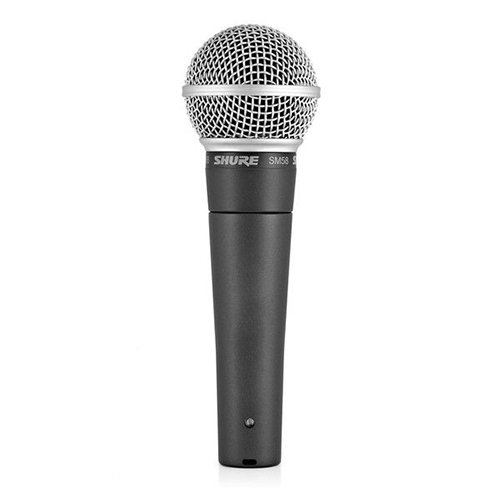

A dynamic microphone renowned for its durability and sound quality, the SM58 is a go-to choice for live performances, studios, and public speaking. Its cardioid polar pattern isolates the main sound source while minimising background noise. Ideal for vocals, the SM58 provides a smooth, extended frequency response.
Taylor's dynamic vocal style, ranging from strong melodic tones to intense screams in some Slipknot songs, finds a fitting partner in the SM58's reliability and versatility.
Jim Root - #4
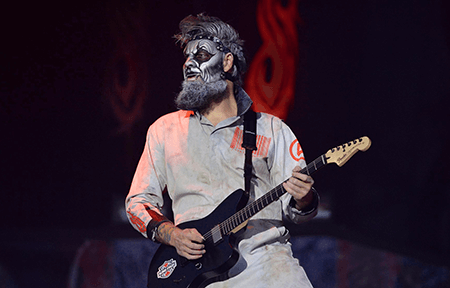

Joining the band in 1999, Root became one of its primary songwriters, contributing to the iconic Slipknot sound. Beyond his work with Slipknot, he was also the guitarist for the Grammy-winning rock band Stone Sour for a long stint. Root's distinctive playing style combines technical prowess with raw energy, earning him acclaim in the metal community. Recognised for his masked jester stage presence, Jim Root remains a vital force in the menacing nine-piece.
What Guitars Does Jim Root Use?
Fender Jim Root Telecaster, White


Jim Root's original signature guitar from 2008 during the All Hope Is Gone era, the distinctive Telecaster, has remained a timeless favourite for over 15 years since its release. It's a perfect match for a new generation of players seeking thick, heavy, high-gain tones without the extreme edges of traditional heavy metal guitars. Since then, the signature
Equipped with EMG active pickups, favoured in metal for their powerful output across all frequencies, it's no surprise that Jim Root and many others opt for these for their crushing riffs. The mahogany body and ebony fretboard provide the perfect combination of ferocity and edge. Visually, its sleek design with a flat white finish and black parts exudes class and subtlety, contrasting with its powerful sound. Yet, the EMG 60 pickup offers versatility, delivering tasteful clean tones amidst the brutality.
Fender Jim Root Jazzmaster, White
The most recent addition to Jim’s collaboration with Fender, the newest incarnation offers a sleek matte white finish as well as being fitted with Jim’s signature EMG Daemonum pickups, which offer a more passive style of pickup for a more “bluesy feel” when the volume is rolled back in comparison to the EMG 81/60 pickups on the previous signatures, which have a more overall compressed tone.
Charvel Jim Root Signature Pro-Mod San Dimas Style 1
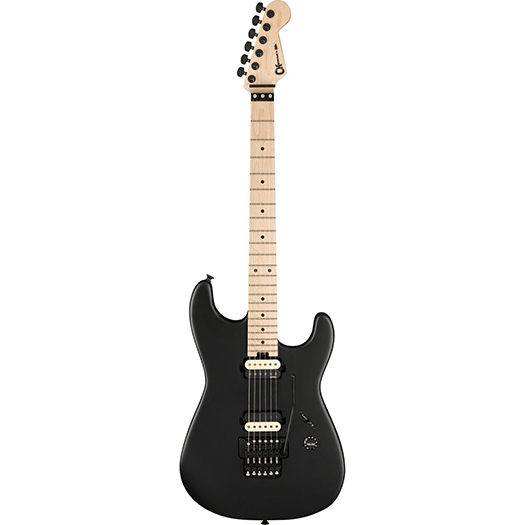

Resurrecting Jim’s go-to guitar of choice before his Fender signature in the Vol 3: The Subliminal Verses days (see the Before I Forget music video), the Charvel Jim Root Signature Pro-Mod San Dimas Style 1 offers ferocious tonality that’s ideal for quintessential Slipknot tones. Fitted with a slick black Floyd Rose on the bridge, this signature Pro-Mod San Dimas opens up a wide array of potential when it comes to playing solos.
Affordable Alternatives
Squier Contemporary Active Jazzmaster HH IL, Sunset Metallic


What Pickups Does Jim Root Use?
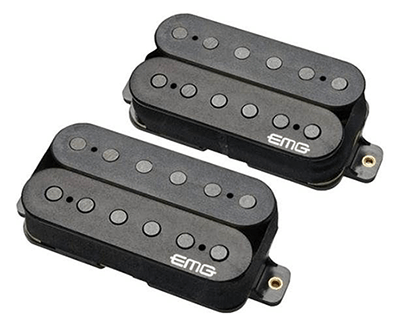

A long-time user of the EMG 81/60 combination, Jim Root began the process of developing a signature set years ago. After trying various prototypes, Root was inspired by a set of modified Retro Active pickups to tailor his tone. He settled on a set that gave him everything he loved from the 81/60 with the added benefits and versatility of the Retro Active design.
Unlike traditional open coil pickups, both the bridge and neck pickup utilise stud poles. The fingerboard pickup uses ceramic studs, giving it a clean high-end percussive tone. The bridge pickup has black steel poles and features a ceramic magnet, similar to the EMG 81. Both pickups feature custom Retro Active preamps exclusive to the Root set.
What Amplifiers Does Jim Root Use?
Orange Rockerverb 100 MKIII
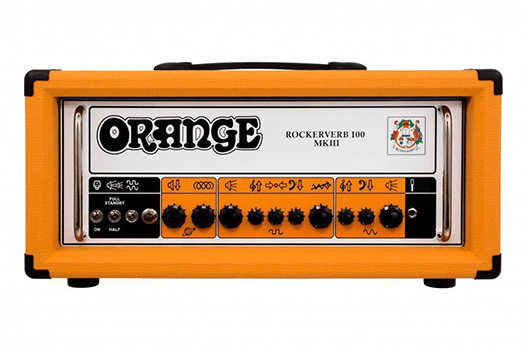

The Orange 4x12 Guitar Speaker Cabinet delivers a formidable sound, meticulously crafted to amplify and enrich the sonic potential of your amplifier. Engineered with precision and outfitted with top-notch speakers, this cabinet is a must-have for guitarists seeking robust power, clarity, and the iconic Orange tone.
Featuring four premium Celestion speakers, revered for their outstanding tone and dependability, the 4x12 cab is meticulously selected to harmonise with the distinctive characteristics of Orange amplifiers. Together, they produce a dynamic and articulate sound that packs a punch.
Orange PPC412 4x12 Cabinet
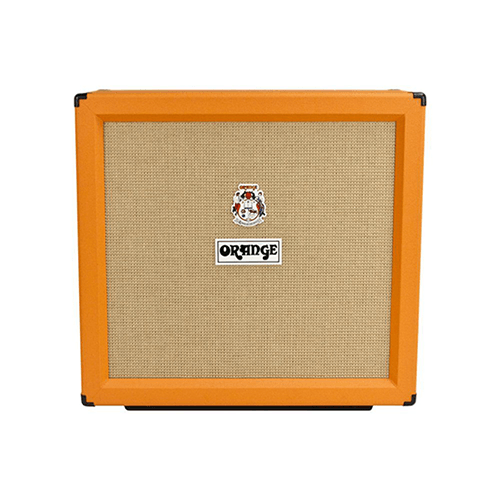

The Orange 4x12 Guitar Speaker Cabinet delivers a formidable sound, meticulously crafted to amplify and enrich the sonic potential of your amplifier. Engineered with precision and outfitted with top-notch speakers, this cabinet is a must-have for guitarists seeking robust power, clarity, and the iconic Orange tone.
Featuring four premium Celestion speakers, revered for their outstanding tone and dependability, the 4x12 cab is meticulously selected to harmonise with the distinctive characteristics of Orange amplifiers. Together, they produce a dynamic and articulate sound that packs a punch.
Affordable Alternatives
Orange Super Crush 100 Combo
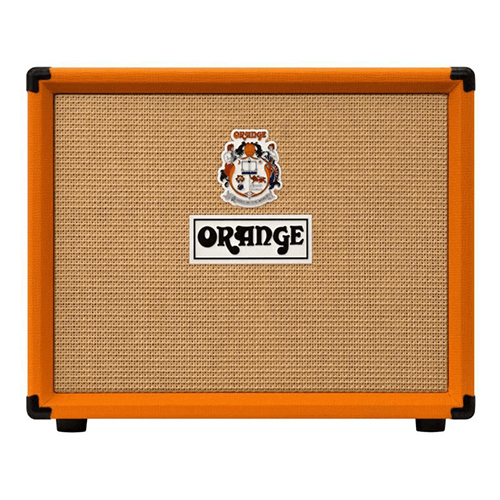

This versatile combo powerhouse boasts a host of enhancements, ensuring your tones soar to greater heights—ideal for replicating Slipknot's diverse guitar tones. From the pristine Clean Channel to the searing high-gain metal tones of the Dirty Channel, its two-channel design offers unparalleled versatility for capturing Slipknot's aggressive yet nuanced sound. With a robust 100-watt Class A/B power amplifier, it delivers valve-like dynamics and presence crucial for emulating Slipknot's intense live performances.
Equipped with a Celestion G12H-150 speaker, the Super Crush 100 Combo provides the perfect platform to replicate Jim's signature tones, whether it's high-headroom cleans or relentless punch.
What Pedals Does Jim Root Use?
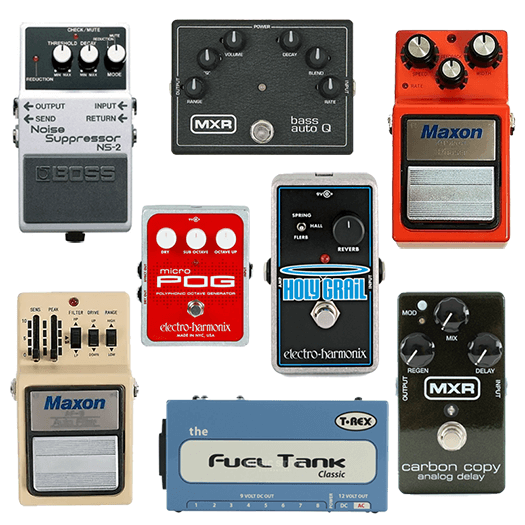

Jim Root's pedalboard setup showcases a blend of classic and modern effects, tailored to his specific sound preferences. Let's break down some of his pedalboard setup:
Boss NS-2 Noise Suppressor (Old Version): Root prefers the old version of the Boss NS-2 Noise Suppressor due to its perceived superiority in sound quality over the updated versions with different circuitry and lead-free solder.
MXR Auto Q Wah: This pedal provides automatic Wah effects, adding dynamic tonal shaping to Root's guitar sound.
Maxon AF-9 Auto Filter: Another auto-wah pedal, the Maxon AF-9 provides further modulation possibilities for Root's sound.
Maxon PT-9 Pro+ Phase Shifter: This pedal adds phasing effects to Root's signal chain, contributing to his distinctive tone.
MXR Carbon Copy Delays (x2): The two Carbon Copy Delays offer Root flexibility in creating varied delay effects with different decay and repeat lengths.
Electro-Harmonix Holy Grail Reverb: This reverb pedal likely provides Root with lush reverberation effects to add depth and atmosphere to his guitar tone.
Electro-Harmonix Micro POG: The Micro POG is a polyphonic octave generator pedal, capable of adding both upper and lower octaves to Root's guitar signal, enriching his sound.
T-Rex FuelTank Classic: This power supply unit ensures reliable and clean power distribution to all of Root's pedals, minimising noise and interference.
Mick Thomson - #7
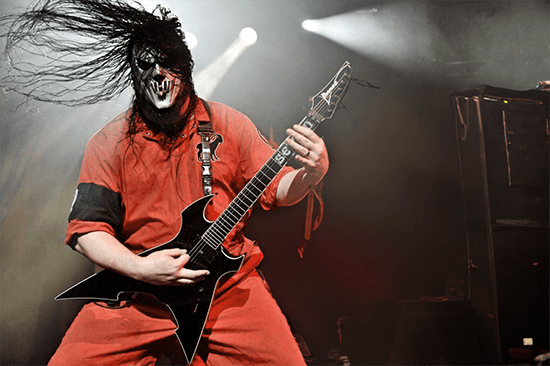

Joining the band in 1996, Thomson's aggressive yet precise playing style has contributed significantly to the band's signature sound. His shredding mastery and intense stage presence have earned him widespread acclaim in the metal community.
What Guitar Does Mick Thomson Use?
ESP Guitars
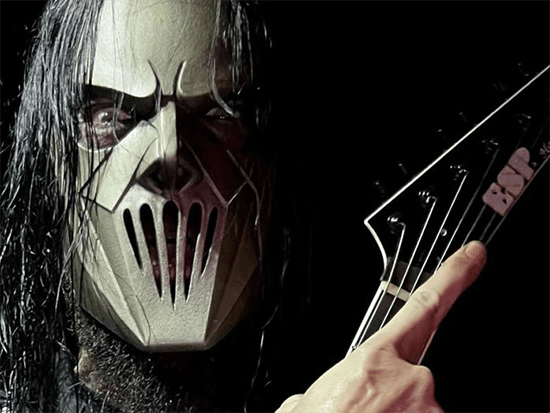

After using Jackson for several years and even having a range of signatures, Mick recently announced that he had moved to the ESP/LTD camp. Though a new signature model hasn’t been announced yet, Mick has been using many models during live sets such as the ESP M-II Custom, the ESP E-II Arrow and the ESP Custom Shop Eclipse, replacing the pickups with his very own signature Fishman pickups instead and a customised bridge.
An Affordable Alternative
ESP LTD M-201HT Electric Guitar, Black Satin


The ESP LTD M-201HT Electric Guitar in Black Satin is an ideal choice for aspiring rock musicians seeking to emulate Mick Thomson's guitar tone on a budget. Featuring a classic S-style body crafted from Mahogany for rich warmth, it boasts effortless playability with a sleek 3-piece Maple neck and Roasted Jatoba fingerboard.
The single-pickup design and rock-solid components including an LTD fixed bridge ensure reliable performance and impressive sustain. With its gig-ready build and high-quality hardware, this guitar offers a no-nonsense option for developing your playing technique and achieving that signature Number Seven sound without breaking the bank.
What Guitar Amp Does Mick Thomson Use?
Omega Ampworks Obsidian
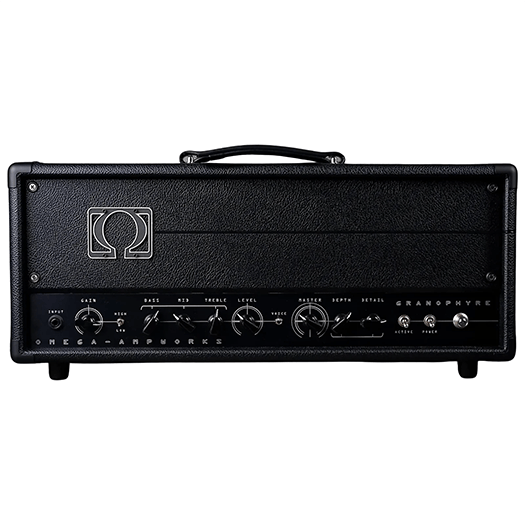

Meticulously crafted to deliver unparalleled tone and versatility, this amplifier embodies Thomson's signature sound and style. The Clean Channel offers a luscious, full sound with remarkable headroom and tonal flexibility, while the Crunch Channel delivers round yet tight lows and a cutting mid-range ideal for southern blues to early metal tones. Transition to the Lead Channel for highly harmonic, dynamic sound with intuitive controls and subtle tone-shaping options.
What Pedals Does Mick Thomson Use?
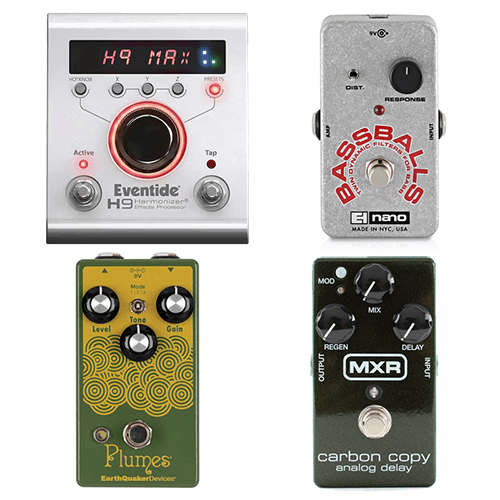

Mick Thomson incorporates various pedals into his live setup, including the Eventide H9, which enhances tracks like "Eyeless" and "Before I Forget." Additionally, he utilises the Electro-Harmonix EH-4250 Bassballs Twin Envelope Follower which can be heard at the start of “Disasterpiece”, the EarthQuaker Devices Plumes, and the MXR M169 Carbon Copy to further sculpt his distinctive sound on stage.
Sid Wilson - #0
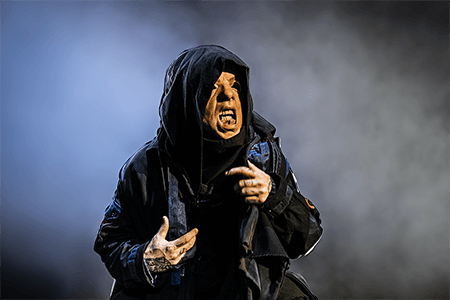

Truly a one of a kind member of the band, Sid Wilson is the longstanding DJ within the nine-piece band. Bringing a distinct sonic element to their intense performances, Sid Wilson’s skilful turntablism adds layers of texture and atmosphere to Slipknot's aggressive sound, contributing to their iconic blend of metal and experimentation.
Though a lot of the equipment he uses can’t necessarily be pinned down and confirmed, here are some of the key parts of Sid’s rig…
Korg Kaossilator Pro
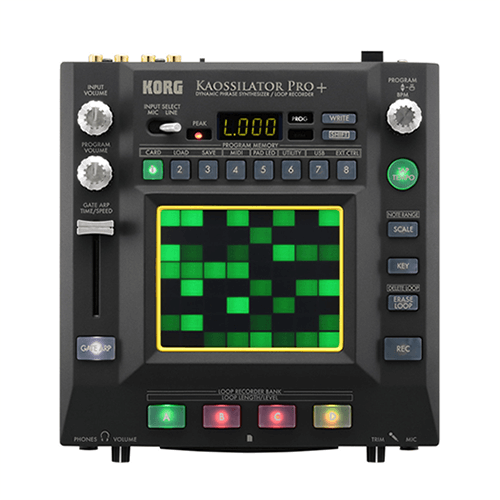

The Korg Kaossilator Pro is a dynamic synthesizer and loop recorder with a unique touchpad interface, allowing for intuitive and expressive control over a wide range of sounds and effects. Sid Wilson of Slipknot incorporates the Kaossilator Pro into his setup to add layers of electronic textures and effects to Slipknot's music during live performances.
He uses the touchpad to manipulate and modulate the built-in synthesizer sounds, creating atmospheric drones, pulsating rhythms, and otherworldly effects that enhance the band's intense soundscapes. The Kaossilator Pro's versatility and real-time control make it a valuable tool for Sid Wilson to add depth and complexity to Slipknot's sonic palette on stage.
Although this model is discontinued, check out the Korg KAOSS Replay Dynamic Effect Sampler.
Numark PT-01 Scratch
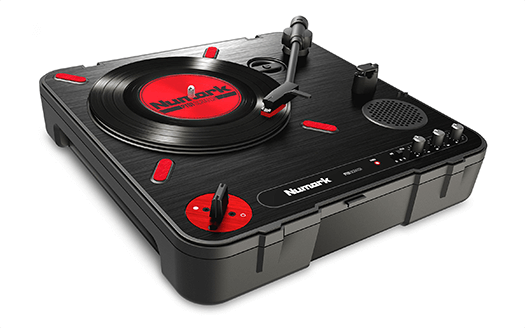

The Numark PT01 Scratch revolutionises DJing with its portable design and built-in scratch capabilities. This battery-operated turntable offers unmatched versatility, allowing DJs to scratch anywhere with ease. Featuring a built-in adjustable scratch slide switch and a protective dust cover with an integrated carrying handle, it's designed for on-the-go performance.
With battery or mains power options, a built-in speaker, and USB connectivity for recording, the PT01 Scratch is a complete portable solution. Its AUX IN connection enables adding background beats, while an adjustable scratch switch accommodates various scratching styles. Record tunes directly to your computer and mix wherever inspiration strikes with the Numark PT01 Scratch.
Record tunes directly to your computer and mix wherever inspiration strikes with the Numark PT01 Scratch.
Alessandro “VMAN” Venturella
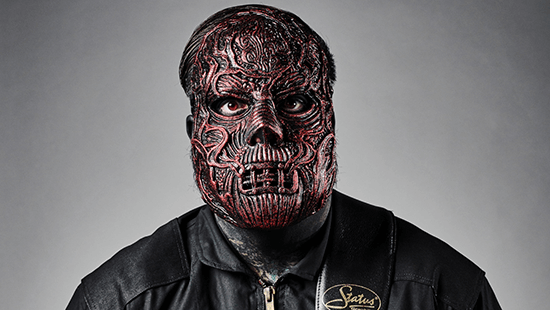

Taking over the bass reins from the late great Paul Gray (#2) in 2014, Venturella's addition brought a new dimension to Slipknot's sonic landscape. His precise and powerful bass lines contribute to the band's intense and dynamic sound, solidifying his place as an integral member of the group. Despite maintaining a low profile, Venturella's talent and dedication to the band shine through in his performances and studio work, taking a big writing role in the band’s latest release “The End, So Far” in 2022.
What Bass Does V-Man/Alessandro Venturella Use?
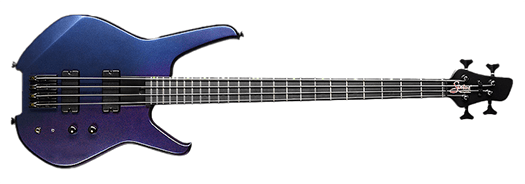

Alessandro "V-Man" Venturella has long relied on Status basses for both live performances and studio recordings with Slipknot. With his invaluable input, Status has refined their classic design to create the "V-Man" Signature Bass. This instrument retains the powerful sound qualities of the Status range while streamlining its appearance. The 18-volt EQ system, accessible through a custom engraved back-plate, ensures precise control over tone without the risk of accidental adjustments.
Featuring only essential front-panel controls, including a pickup blend, master volume, and midrange pre-shape boost/cut switch, this bass offers simplicity and versatility. Custom-wound Status hum-cancelling pickups deliver a full yet punchy tone. Finished in a striking chameleon smooth satin lacquer, with luminous side neck markers, the "V-Man" Signature Bass stand out even on stages as busy as Slipknots.
Jay Weinberg (Drummer, 2014 - 2023)
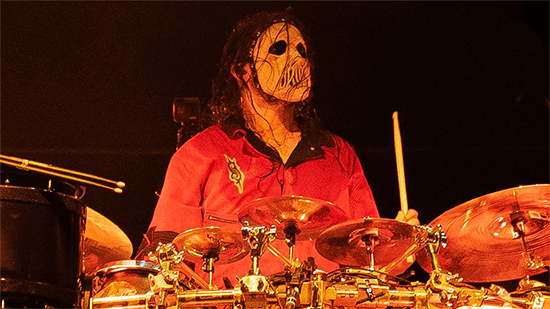

Though Jay Weinberg recently departed from his drumming duties with Slipknot, he was the drummer for almost a decade, so it’s worth running through what set-up he used whilst in the band after taking over from the iconic Joey Jordison in 2014.
SJC Custom Drum Kit
Jay Weinberg's drum kit is a powerhouse of precision and power, crafted by SJC Custom. Consisting of two 22x14 kick drums, 10x7, 12x8, and 13x8 toms with 5-ply maple shells reinforced with rings, as well as 16x16 and 18x16 floor toms with the same construction, Weinberg's setup is designed for maximum impact.
Equipped with Evans G2 clear batter heads and G1 resonant heads, each drum is meticulously mic'd from the inside to minimise cymbal bleed and achieve a clean, bombastic sound. Featuring die-cast hoops for tuning stability and controlled tone, Weinberg's kit is a masterclass in drumming precision and power.
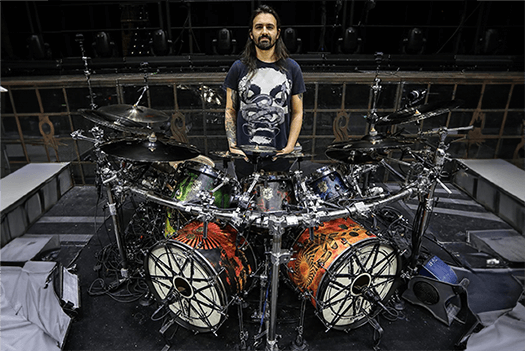

What Snare Does Jay Weinberg Use?
SJC Custom Drums Jay Weinberg Signature Snare Drum - "The Crucible" - 6.5-inch x 14-inch
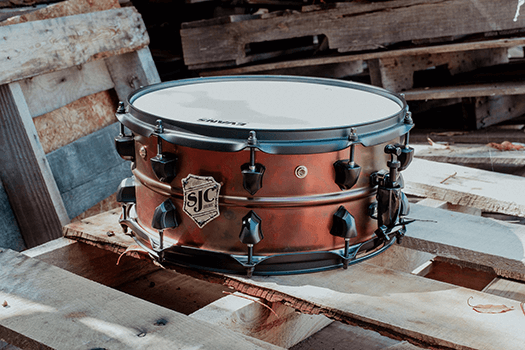

Crafted with meticulous attention to detail, The Crucible boasts a premium brass shell that exudes strength and durability. Its beaded construction enhances structural integrity, ensuring longevity. With dimensions of 6.5 inches deep and 14 inches across, this snare delivers a robust sound to match its imposing appearance. The inclusion of four brass air vents enhances sustain and resonance, elevating the sonic experience. Below the surface, 30 strand wires maintain crispness and tightness, allowing each strike to cut through the mix effortlessly.
What Cymbals Does Jay Weinberg Use?
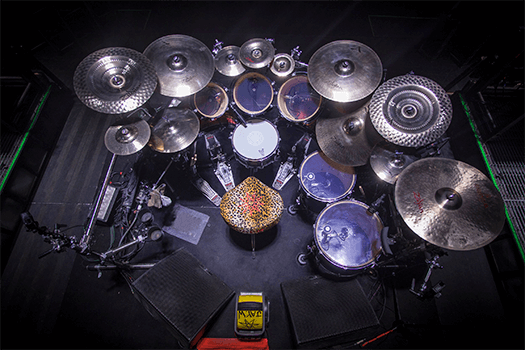

Jay Weinberg's drum kit is complemented by an array of Zildjian cymbals meticulously selected to enhance his dynamic playing style. His setup includes Zildjian 14" A Custom Hi-Hats for crisp articulation, an 8" hybrid Splash for accents, and dual 18" Ultra Hammered China cymbals for explosive crashes. Adding texture to his sound is an 18” A Custom EFX and a 12" FX Spiral Stacker. Weinberg's kit features two 20" A Custom Crashes for rich, full-bodied crashes, alongside a 10" Reso Splash and a 10" Trashformer for nuanced effects.
Completing his setup are a 10" Oriental China, 6" Zil Bel, and 13" A Custom Hi-Hats for versatile soundscapes. Additionally, Weinberg incorporates a 24" Crash Of Doom, occasionally swapping it for a 20", and anchors his beats with a commanding 22" S Rock Ride. For added intensity, he occasionally introduces 18" Oriental Trash Chinas into his performances.
Additional Hardware
- DW 9002 Double Bass Drum Pedal
- Vater Drink Holders and Stick Holders
- Vater Jay Weinberg Signature Drumsticks
Shawn “Clown” Craham - #3
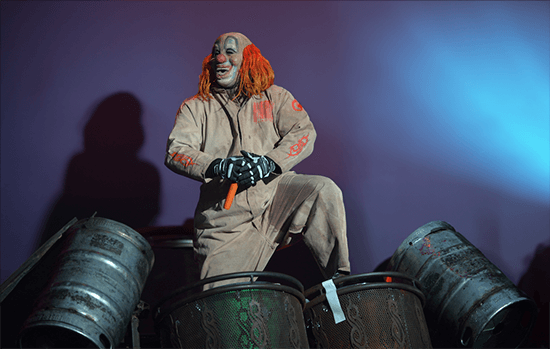

Shawn Crahan, often referred to as "Clown," is a founding member and the percussionist of the band. Crahan is known for his distinctive mask and theatrical stage presence, which adds to Slipknot's enigmatic persona. Apart from his percussion duties, he is also involved in the band's visual elements and stage production. Crahan's contributions to Slipknot extend beyond music, as he has played a crucial role in shaping the band's aesthetic and identity.
Stainless Steel 1/2 Keg
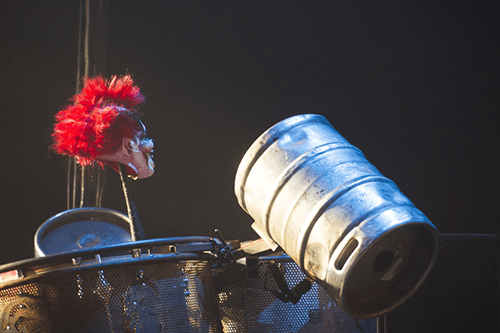

You read it correctly. Use a baseball to replicate the metallic clang. Both Clown and fellow percussionist, Michael Pfaff, use these on stage.
SLIPKNOT GEAR SUMMARY
And that’s it, a brief run-through of the gear Slipknot uses on stage. To summarise, Corey uses a Shure Microphone, Jim Root uses Fender and Charvel guitars along with Orange Amps, Mick Thomson now uses ESP guitars and Omega Amplifiers, V-Man uses a signature Status bass guitar, Jay Weinberg used an SJC Custom Drum Kit with Zildjian cymbals, and Sid Wilson uses a mixture of DJ gear including a Korg Kaossilator Pro and various turntables.
So hopefully we've answered any questions you might have about what equipment Slipknot uses. Live and studio setups are constantly evolving and changing so if you have any further or new information then don't hesitate to get in touch.
If you require more information or help on any of the guitars, drums or accessories you've seen in this gear guide then visit PMT Online or call into your nearest PMT Store and speak to one of our friendly experts.

